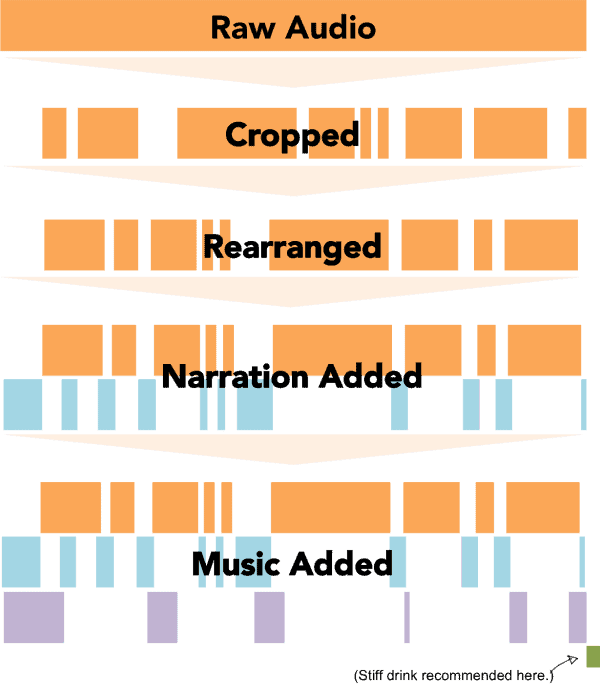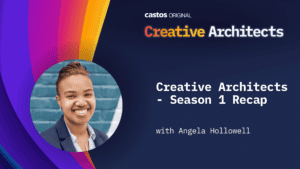Six weeks into this experiment and a handful of data analyses later, we discovered our narrative style episodes were driving the most engagement. More listeners were tuning in the first day the episode dropped and the passive listens over time continue pouring in.

Keeping our eyes on the growth prize, we committed to producing more content our audience showed us they want to hear. But creating a narrative podcast requires a bit more preparation and intention than a standard interview. So in this episode of Audience, we’re unveiling what goes into producing a narrative episode to craft the most engaging story.
To dip our toes into these new waters, we first need to understand what makes a narrative podcast different from other formats.
What Is A Narrative Podcast?
First things first, a definition. What is a narrative podcast? The Art Of Podcast defines it as an audio documentary that follows a story arch. Rather than including an interview in full, the episode is comprised of clips, scripted segments, and music to tell the story in a non-linear way.
When you think of narrative podcasts, you’re likely referencing a show produced by NPR or Gimlet Media. Both are the gold standards in this style of storytelling. If you close your eyes, you can probably hear Ira Glass or Jonathan Goldstein narrating an episode, cluing listeners into the most interesting parts of the interview.
Given the success of the shows produced by each of these powerhouse networks, narrative podcasts must be a lucrative way to engage an audience. But why?
Why Narrative Podcasts Engage An Audience
In 2014, The Harvard Business Review set out to figure out why storytelling is such a powerful way to convey information. Their research found “character-driven stories with emotional content result in a better understanding of the key points and enable better recall weeks later”.
We learned narrative storytelling follows a non-linear path, fleshing out characters and storylines. By ramping up the drama and suspense, the narrative format generates emotions in listeners, wiring them to connect more with the content. Their results mark a common thread between stories that produce engagement and narrative podcasts.
Even outside of the science, podcasters have found success with narrative episodes. As of this publication, 5 of the top 10 podcasts in the US follow this format. As listeners, we gravitate towards shows where hosts lead us through the three acts of their story, playing off our emotions every step of the way.
We think it’s safe say this style of storytelling is here to stay. To try your hand at this episode format, let’s get into how to create a narrative podcast.
How To Create A Narrative Podcast
Creating a narrative podcast happens at every stage of the process–before you start recording, when you’re actually recording the interview, and especially within post-production. As a host, you’ll need to approach this episode style in a more intentional way. A narrative doesn’t typically come off the cuff.
Instead, you’ll need to manipulate and massage the raw files into the narrative you want to tell. Let’s get started with what to prepare before you even hit record.
Pre-production preparation
Preparing to produce a narrative podcast episode follows similar guidelines you should use for every interview. Use these two tips to get yourself ready:
- Do your homework: research your guest’s past interviews, latest blog posts, or tweets. Have a firm understanding of the topic you’ll talk about from recent news stories to how others in your industry are speaking about it. There’s no such thing as being over prepared here.
- Draft and share your questions: outline your key questions and provide them to your guest so they can fine tune their soundbites. You’ll end up with more quote-worthy content and your guest will feel prepared going into the interview, win/win.
As you’re finalizing the interview details, it’s also a good idea to remind them about the narrative style. Knowing their answers aren’t being repeated verbatim can take the pressure off some guests and make the interview more conversational. It’s then your job to include interjections to clarify miscellaneous points and package everything together.
Use this Interview Preparation–Narrative Podcast template to organize your research and questions ahead of each interview.
Episode recording preparation
Interview preparation in hand, it’s time to head into the interview prepared and ready to capture your story. When you sit down with your guest, follow these tips to set yourself up for success:
- Let your outline guide you: use the content clusters you previously organized to set the scene and provide structure
- Let the conversation have a life of its own: try going off script to probe into the why, how, and who to squeeze more from your guest’s answers
- Let your guest be the storyteller: prop up your guest to take the reins in telling their story. Set them up to tell their story in the most compelling way.
- Don’t be afraid of repeats: if you or your guest isn’t satisfied with an answer, repeat the whole response again until you get it right. Since you’re already planning on splicing the interview into parts, it’s easy to remove the mistakes and take less pressure on getting answers in one take.
But our main tip is one that feels counter-intuitive. In a normal conversation, you acknowledge a person’s answer with your own interjection like ‘uh-huh’. But for a narrative interview, keep those normal conversation cues to a minimum.
Instead, take a beat after each answer and immediately follow it up with another question. It won’t sound like a natural conversation while you’re mid-interview, but the magic you work in post-production will make everything flow together.
Post-production preparation
This is where the hard work really starts. You’ll cut up the interview, rearrange it, source outside clips, and weave in musical interludes to produce the final product.
In addition to the standard audio mastering work that goes into every episode, crafting a narrative podcast is time heavy.

To start, you’ll import the raw interview and music into your podcast editing tool. Listen to the full recording and take notes with timestamps about where you want to include narration. Approach your narrations as a way to add more color to your guest’s answers or to provide your own take.
Then go back and make all of the narrations in one sitting. You’d be surprised at how much you voice can change throughout the day so to keep it consistent, capture it all at once.
Last, splice together the narrations, interview clips, and music transitions into one engaging story. Use music transitions to signal when you’re narrating versus when you were responding as the interviewer.
In the end, you’ll be left with a captivating narrative podcast that your listeners won’t be able to stop binging.
Episode Show Notes
Our audience’s two favorite episodes to date featured highly produced interviews that featured a narrative storytelling style. In episode 11 of Audience, Creating A Narrative Style Interview, we dig into the details of what this format entails.
At the jump, we highlight clips from our previous episodes that embody a narrative podcast structure. We pick apart why the narrations helped create a more engaging story and reveal the editing process behind creating each clip.
Throughout, Craig also adds color on how to adopt a narrative podcast format for your own show. Starting with how to prepare for an interview then moving to coaxing your guest into telling an interesting story. At the end, we talk through to how to cut, splice, and manipulate your raw recordings into one cohesive narrative podcast. Grab a pen and paper, you’ll want to take notes during this section.
Tune into Audience now and take your storytelling skills to the next level.
Resources Mentioned
- Catch our interview with Jack Rhysider of Darknet Diaries here
- Interview Preparation–Narrative Podcasts template
- Out on the Wire by Jessica Abel
- Additional resources on how to create a narrative podcast
- Podcast Hackers Facebook group
- Subscribe to Audience


